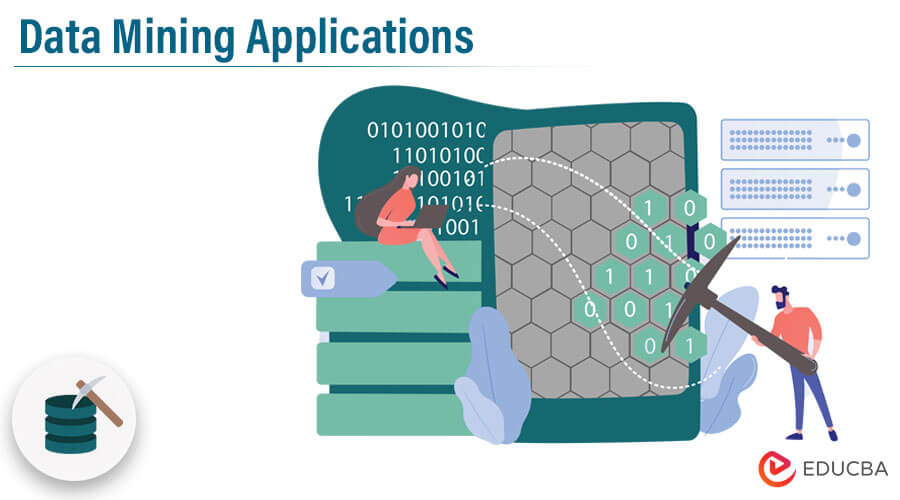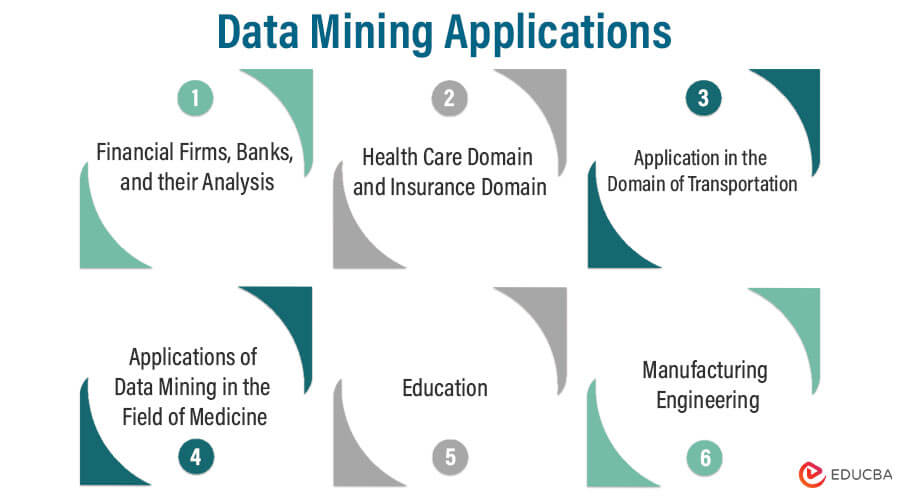Overview of Data Mining Applications
Data mining is how the patterns in large data sets are seen and discovered using intersecting techniques such as statistics, machine learning, and ones like databases systems. It involves extracting data from a group of raw and unidentified data sets to provide meaningful results through mining.
The extracted data is then used further by transforming it and ensuring that arranged to provide the best service possible per business requirements and needs. In this article, we will read about the various applications associated with data mining.
List of Data Mining Applications
Here is the list of various Data Mining Applications, which given below –
1. Financial firms, banks, and their analysis
Many data mining techniques involve critical banking and financial data providing and keeping firms whose data is essential. One such method is distributed data mining, researched, modeled, crafted, and developed to help track suspicious activities or mischievous or fraudulent transactions related to credit cards, net banking, or any other banking service.
The analysis becomes quite simple after sampling and identifying a collection of customer data. Furthermore, tracking suspicious activities becomes a comparatively more straightforward process by keeping a tab of the parameters such as the period of transactions, geographical locations, mode of payments, customer activity history, etc. Based on these parameters, the customer’s relative measure seems derived, put to any form of usage based on the indices calculated.
The bank can retain their customers or work in acquiring a new set of customers by performing the right set of data mining on the historical data and the nature of their activities. Information plays a huge role in the success and failure of any organization, especially after the advent of big data. Companies launch appealing offers based on the customer’s activity and previous transaction and purchase trends. Data mining is to discover the relationship between various financial indicators. Data mining was used to analyze the patterns, rise, and fall of the stock markets and predict future trends.
2. Health care domain and insurance domain
The data mining-related applications can efficiently track and monitor a patient’s health condition and help in efficient diagnosis based on past sickness records. Similarly, the ability to convert data into knowledge or provide various details about customers, markets, and prospective competitors is vital to the development of the insurance industry. As a result, all companies that used data mining techniques effectively reaped benefits. It is used over the claims and their analysis, i.e., identifying the medical procedures claimed together. It allows for the forecasting of new policies, the detection of risky customer behavior patterns, and the detection of fraudulent behavior.
3. Application in the domain of transportation
The historic or batch form of data will help identify the mode of transport a particular customer generally opts for going to a specific place, says his home town, thereby providing him exciting offers and heavy discounts on new products and launched services. This includes targeted and organic advertisements that help identify potential customers and generate leads for conversion. It is also helpful in determining the distribution of the schedules among various warehouses and outlets for analyzing load-based patterns.
4. Applications of data mining in the field of medicine
In medical analysis, a patient’s case is examined by tracking their clinic visits and vacation season. It also helps in the identification of patterns that have successful medical therapies for various kinds of illnesses. Researchers are collecting multi-dimensional data to provide extensive and improved care while reducing costs and enhancing the quality of services. Other approaches, such as soft computing, statistics, data visualization, and machine learning, efficiently gauge and predict patients’ data volume within a single category. The processes are to ensure that the patients receive appropriate attention whenever needed. It also helps healthcare and medicine-based insurers detect fake and fraudulent cases.
5. Education
In education, the application of data mining has been prevalent, with the emerging field of educational data mining focusing mainly on the ways and methods by which the data comes from age-old processes and systems of educational institutions. The goal provides making a student grow and learn in various facets using advanced scientific knowledge. Data mining plays a significant role in delivering education departments with the right quality of expertise and decision-making content.
6. Manufacturing Engineering
The data assets by ensuring that the manufacturing enterprise possesses the right set of knowledge, as its resources lie in identifying the right set of product portfolios, product architecture, and customer needs and requirements. Moreover, efficient data mining capabilities can ensure that product development is completed in the relevant time frame and does not exceed the budget allotted initially.
Conclusion
We have studied a basic overview and a layout of various data mining applications in different domains. This limitless technique has the potential to extend beyond specific sectors and benefit every aspect of a business.
It is only about the correct techniques and some analysis to make your usual regular business different from competitors. Efficient data management is crucial for organizational growth, particularly in today’s society, where data plays a critical role.
Frequently Asked Questions(FAQs)
Q1. What are the most common applications of data mining?
Answer: Banks used data mining to understand market risks. Because of the increased number of channels, banks collect a massive amount of data (mobile banking, retail banking, ATM, internet banking, etc.). Relevant data is from the enormous amount of data available to assist banks in making better decisions. Besides that, data mining can help with customer segmentation and profitability, cash management, forecasting operations, optimizing stock portfolios, credit scores, and approval.
Q2. What does data mining give some applications?
Answer: Data mining is a technique for extracting and organizing data from multiple sources to derive valuable insights.
The most important applications of data mining
- Financial Analysis: Financial and user data serve in loan markets for a wide range of purposes, such as predicting loan payments and determining credit ratings, and data mining techniques help to make such tasks more manageable.
- Retail Industry: Modern retail companies are designing and building data warehouses to reap the benefits of data mining fully. Multi-dimensional data analysis aids in dealing with data from various types of customers, products, regions, and time zones. Online retailers can also recommend products to increase sales revenue and track the success of their promotional campaigns.
- Spatial Data Mining: Data mining using Geographic Information Systems (GIS) and other navigation applications to secure vital information and understand its implications.
Q3.What are the four main data mining techniques?
Answer: Clustering: Clustering is the identification of similar classes of objects. We can discover overall distribution patterns and correlations among data attributes by using clustering techniques to identify dense and sparse regions in object space.
Association: The association aims to find frequent item set findings in large data sets. This type of discovery assists businesses in making decisions such as catalog design, cross-marketing, and customer purchasing behavior analysis.
Classification: The most common data mining technique is classification, in which a set of pre-classified examples develops a model that classifies the entire population of records. This type of analysis is particularly well suited to fraud detection and credit risk applications.
Neural network: A neural network is a collection of connected input/output units, each with its weight. Neural networks have the remarkable ability to extract meaning from complex or imprecise data, and they use to extract patterns and detect trends that are too complex for humans or other computer techniques to notice.
Recommended Articles
We hope that this EDUCBA information on “Data Mining Applications” was beneficial to you. You can view EDUCBA’s recommended articles for more information.



